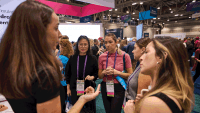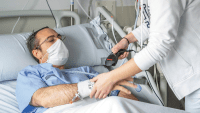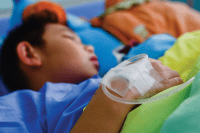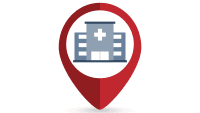A partnership continues in support of patients and nurses.
- Magnet4Europe (M4E) is a 4-year European Union–funded project that began in January 2020 to improve the mental health and well-being of healthcare professionals in Europe.
- Magnet4Europe implemented a multi-faceted strategy by adopting the Magnet blueprint and one-to-one pairing with an experienced Magnet-recognized U.S. hospital and participating in learning collaboratives.
- Partnership (twinning) allows the two organizations to share best practices and strategies to address common challenges facing nursing and healthcare in general.
Magnet4Europe (M4E), a 4-year European Union (EU)-funded project, includes more than 60 hospitals in six European countries (Belgium, Germany, Ireland, Norway, Sweden, and the United Kingdom) and 67 U.S. hospitals that have received recognition from the American Nurses Credentialing Center Magnet Program®. The project aims to improve mental health and well-being among European health professionals. Achieving this goal requires redesign of healthcare work environments to improve job-related outcomes for nurses and physicians as well as health outcomes for patients.
One-on-one partnerships (twinning) between European hospitals and Magnet-recognized U.S. hospitals aim to adopt the Magnet blueprint and gap analysis tool. These learning collaboratives offer opportunities to share best practices, create networks, and develop actionable feedback reports.
Partnering for nursing advancement
Twinning
In November 2020, Hackensack Meridian Jersey Shore University Medical Center (HM-JSUMC), a six-time Magnet-designated hospital in Neptune, New Jersey, was twinned with Klinikum Lüneburg (KL) in Germany. Collaboratively, the hospitals identified current standards and opportunities for improvement. In one-to-one discussions, group presentations, and virtual observations and attendance at council and committee meetings, the U.S. team shared best practices, policies, and tools to address gaps.
Identified gaps and initial actions
Immediate needs identified included educating the KL nurses and interdisciplinary team on Magnet principles and practices to build and embed its culture. They began by creating an interprofessional Magnet council. The KL Magnet Program Director (MPD) recruited nurses and other professionals who showed interest, passion, and commitment to Magnet. Clinical nurses, nurse managers, nurse directors, and three physicians from surgery, obstetrics, pediatrics, internal medicine, critical care, emergency, geriatrics, neurology, and endoscopy joined the 12-member council.
The council met monthly to discuss the gap analysis and how to address it. Significant accomplishments included the creation of the KL professional practice model. To enhance communication and continue to educate employees, the council created a newsletter, which also became a platform for recognizing promotions and work anniversaries as well as welcoming new hires, including nurses from Mexico.
During a 4-day site visit to Germany, the KL and HM-JSUMC teams shared best practices and strategies to address common challenges. Their discussions made clear that KL leadership, interprofessional teams, and nurses have a strong desire to improve the work environment and incorporate the Magnet culture. Unique to the organization was having three physicians as active members of the Magnet council. KL also has a Worker’s Council, chaired by a nurse, which represents and advocates for all employees. Similar to most organizations, KL also has a dedicated MPD who leads initiatives and serves as the point person for the M4E collaborative.
Key areas identified for improvement included rewards, recognition, and support for training and education to aid nurse retention; strategies for recruitment; enhancement of physician–nurse relationships and collaboration; exploration of ancillary and support staff (certified nursing aids or patient care technicians) to support nurses; and empowerment of nurses for shared decision-making and accountability in patient outcomes and a healthy work environment. The team also identified the need for national benchmarking to allow hospital performance comparison.
To provide KL nurses with first-hand experience and observation, the group, in collaboration with the KL president, planned a visit to HM-JSUMC. They scheduled the visit for October to coincide with the Magnet Conference® and Pathway to Excellence Conference® so the KL nurses could attend. (To learn more about the HM-JSUMC visit to Germany, visit myamericannurse.com/magnet4europe.)
Magnet® in a nutshell
Organizations that have received Magnet® recognition develop a culture that embeds a continuous evaluation of the organization’s strengths, weaknesses, and performance in relation to the Magnet model and components (Transformational Leadership, Structural Empowerment, Exemplary Professional Practice, New Knowledge Innovations and Improvements, and Empirical Outcomes). They then implement changes that allow nurses to lead and advance healthcare.
U.S. site visit
In October 2023, four KL nurses visited HM-JSUMC for 3 days. In addition to the MPD, a pediatric clinical nurse, an assistant nurse manager/lactation consultant, and a medical-surgical nurse manager attended.
The HM-JSUMC MPD prepared an agenda that allowed each KL nurse to shadow a U.S. nurse of the same/equivalent position and observe day-to-day activities and responsibilities. The agenda also included unit tours and observation of shared decision-making, leadership functions, interdisciplinary collaboration, reward and recognition programs, and recruitment and retention initiatives, as well as processes that highlight the organization’s culture of high reliability to support the best patient outcomes, patient experience, and healthy work environment. (Visit myamericannurse.com/?p=402897 to view a list of questions the KL team asked of the HM-JSUMC team.)
Transformational leadership
The HM-JSUMC leadership team (president, chief nursing officer [CNO], nurse directors, and shared governance council chair) welcomed the KL nurses. Over breakfast, they discussed the HM-JSUMC nursing structure, the organizational chart, and the services offered.
Next, the KL team met with the hospital’s senior leadership and medical executive board, which includes each specialty department’s medical directors/lead physicians. Discussions focused on building partnerships among physicians and nurses and developing interprofessional collaborations and projects. A meeting with nurse managers highlighted their leadership responsibilities; training and preparation before assuming their leadership role; concerns delegated to assistant nurse managers (staffing and covering callouts and sick leaves); strategies for engaging teams in shared decision-making; and functions of ancillary support staff (such as patient care technicians, which Germany doesn’t have).
The KL nurses also observed the nursing leadership team “communication” meeting, which was led by the CNO and attended by all nursing leaders. The meeting provides an opportunity to discuss any topic affecting nursing and provide hospital updates. A meeting with the MPDs from sister hospitals showcased collaboration and partnership as well as their roles and responsibilities.
Structural empowerment
Competency assessments are a new process for KL nurses, so they observed sessions conducted by the HM-JSUMC nurse educator and advanced practice nurse for the cardiac catheterization lab staff. The educators use this time to validate staff competency via testing and return demonstrations; they also teach new skills and concepts and the use of new equipment.
Meetings with professional development staff, educators, the RN residency team, and partner schools emphasized orientation, transition into practice, competency activities and validation, scholarship and tuition reimbursement support for nurses to pursue specialty certification and advanced education, and partnerships with area schools of nursing for student clinical experiences and rotations as well as recruitment. These activities provided evidence of the strong HM-JSUMC organizational support for advancement and successful transition.
The KL nurses also sat in on the HM-JSUMC professional practice/shared governance meeting, which showcased nurses’ involvement in shared decision-making—from policy review and approval to updates from the CNO and each of the unit-based council chairs’ unit reports. They met with the human resources, volunteer services, chaplain/spiritual, and culture teams to discuss the organization’s well-being and support program, retention and recruitment efforts, and partnership and support of ancillary teams. The KL nurses noted the organization’s strong security presence and the emphasis on zero tolerance of workplace violence.
Exemplary professional practice
While shadowing their HM-JSUMC equivalents, KL nurses observed bedside shift reports as well as morning medication administration. The KL nurses also followed the HM-JSUMC nurse manager, assistant nurse manager/lactation consultant, and nurse director and observed the daily safety huddle where each department reported actual and anticipated safety concerns. Other areas of discussion included bed status, ED patient holding, and anticipated discharge, as well as any updates.
The KL nurse shadowing the HM-JSUMC clinical staff nurse observed her care for patients in the pediatric unit, including carrying out physician orders, providing referrals, and escalating any patient concerns or changes in status. The assistant nurse manager/lactation consultant shadowing the U.S. lactation consultant observed the maternity unit report, where the physician discussed each patient’s current status and care plan. They then proceeded to round on newly delivered mothers to teach them about breastfeeding and encourage continued bonding. They then went to the outpatient lactation service center, where follow-up visits of recently discharged patients occur.
The KL nurse manager observed the U.S. nurse manager during nurse leader rounding on each patient in her unit, following up on any concerns or needs as well as patient plans of care. They also participated in interprofessional rounds, which include discussion of patient care plans to identify and address any needs to facilitate discharge or transfer.
A KL nurse followed the U.S. nurse director as she rounded in all of her reporting units. In one of the units, a rapid response was called for a patient who had a change in his baseline condition. Rapid response isn’t practiced in Germany, so observing it gave the KL nurse an opportunity to see how the interprofessional team works collaboratively to address and treat the cause of the change in the patient’s condition.
The KL nurses noted how each meeting starts with a focused recognition as well as patient safety stories. They also remarked on a better nurse-to-patient ratio (compared to their 1:10) and the use of whiteboards in the patient’s room with patient information (such as plan of care), vital hospital information (emergency, concierge, dietary team phone numbers), and interprofessional team members’ names so that patients know who’s caring for them. The KL nurses felt that Germany’s privacy laws would prohibit use of whiteboards in this way.
Meetings with the quality and outcomes, patient experience, medication safety, infection prevention, and wound care teams included discussion of data collection, sharing, and comparison to benchmarks among units within the hospital and nationally with similar hospitals. These meetings afforded opportunities to present quality improvement projects on infection and pressure injury prevention as well as the use of medication barcoding and medication dispensing cabinets to enhance medication safety. This information further emphasized the need for collection and benchmarking of quality data and patient and nurse satisfaction, which doesn’t currently exist in Germany.
New knowledge, innovation, and improvement
The KL nurses met the nursing research council chair and members as well as the nurse scientist to discuss their roles in supporting nursing research and scholarly work. They also reviewed the role of the institutional review board (IRB) in protecting research participants’ rights. The HM-JSUMC team presented one of their research projects to the KL nurses to demonstrate the steps they took—from forming a research idea to developing the protocol, submitting the IRB approval, collecting and analyzing data, and disseminating findings. The KL nurses noted that having nurse scientists and organizational support encouraged nurse involvement in research and other scholarly projects.
Next steps
The KL nurses returned to Germany inspired to continue their Magnet journey. They shared what they learned, emphasizing a plan to adopt some of HM-JSUMC’s processes. The next month, the MPDs from both hospitals met virtually to complete KL’s second gap analysis and discuss next steps. The KL team started by recognizing nurses with an ice cream social during World Nurses Day, and they plan to implement interprofessional rounds and unit-based council chairs.
Common gaps identified in all M4E twinnings include lack of national benchmarks in the EU to enable hospital performance comparisons as well as differences in educational degree equivalents and national nursing specialty certifications. Identification of these gaps led to developing international interpretations from the Magnet Program office to help twinned hospitals determine the equivalent degree, professional development activities, and benchmarks.
To help meet Magnet leaders’ educational/academic and licensure requirements, M4E participant degrees obtained in the EU initially were recommended for submission to the Commission on Graduates of Foreign Nursing Schools (CGFNS) International for evaluation and verification. Applicants can then submit the verification from CGFNS International as part of their application to meet the education eligibility requirements. The international interpretation also provided guidelines on using professional development activities as an alternative to professional board certification requirements.
On April 1, 2024, ANCC updated the International Interpretation of the 2023 Magnet® Application Manual so that those who obtained baccalaureate (BSN) or higher degrees in nursing outside of the United States don’t require evaluation for comparability to a U.S. degree. Bachelor’s degrees in non-nursing subjects do require review by CGFNS, which is solely responsible for determining educational credential comparability.
The requirement for an externally managed database to collect data from multiple organizations and provide benchmarks related to nurse-sensitive clinical quality indicators remains to be addressed. Five German hospitals, all currently part of the M4E collaborative, found three common themes related to this issue. First, little nurse-sensitive data exist; most hospitals collect data only on hospital-acquired pressure injuries and falls with injuries. Second, the hospitals noted the importance of creating and enabling a data collection culture where employees accept data collection and see themselves as facilitators to using it in the clinical setting. Third, they acknowledge the challenges and opportunities in establishing benchmarking to standardize indicators, data collection, and comparative groups.
This information, presented at the Magnet4Europe Learning Collaborative in Cork, Ireland, in May 2022, not only prompted discussions about the data collection gap but also paved the way for the five hospitals to establish data collection and benchmarks through the B·IN Pflege project, which has expanded to include 10 hospitals. Their journey to address the benchmarking gap has just begun, but the possibilities for influencing nursing’s role, the work environment, and patient outcomes appears promising. (See What’s next?)
- Leader-facilitated team building activities to enhance the relationships among physicians and nurses
- Leader-facilitated initiatives to enhance the image of nursing
- Communication of performance metrics data and results to nursing leaders and clinical nurses to empower and partner with them for improvement
- Continued leadership support for embedding the Magnet culture and improving the work environment
- Continued use of a newsletter to keep nurses and team members informed
- Reward and recognition program development
- Market analysis of RN salaries and benefits
- Ancillary support staff to assist in RN workload
- Recruitment initiatives (internal recruitment)
- Retention strategies (education and career advancement assistance and opportunities)
- Collection and benchmarking of nurse-sensitive indicators and RN and patient satisfaction
- Evolving professional practice model to reflect the organization’s and nursing’s goals and priorities
- Training and staff engagement in performance improvement, evidence-based Improvement projects, and research
- Use of newsletter to disseminate project and research information
- Expansion of evidenced-based design of units and departments
In April 2024, the 2023 Magnet® Application Manual included an important international accommodation on benchmarking, which waives the requirement to use an approved vendor. This means that if no national benchmark is available, which is the case throughout Europe, hospitals may use an “internally established benchmark,” which can be based on professional standards, literature review, or internally trended data.
Implications for nursing
Magnet-recognized organizations promote nurses’ autonomy and empowerment. Incorporating nurses’ opinions into patient care results in better outcomes and experiences. Nurses’ voices improve the working environment that enhance innovation, which cultivates growth and promotes job satisfaction and retention. Every organization around the world should set these as their ultimate goals. The initial desire of EU hospitals to improve the work environment led to the M4E collaboratives. This paved the way not only for putting nurses at the center of positively influencing practice and outcomes but also created long-term partnerships, friendships, and relationships.
Rocel Besa is the Magnet Program Director at Hackensack Meridian Jersey Shore University Medical Center in Neptune, New Jersey. Ellen Angelo is the vice president and chief nursing officer at Jersey Shore University Medical Center. Katrin Mueller-Duemke is the nurse director and Magnet Program Director at Klinikum Lüeneburg in Lüeneburg, Germany.
American Nurse Journal. 2024; 19(9). Doi: 10.51256/ANJ092448
References
American Nurses Credentialing Center. International information for the Magnet Program. nursingworld.org/organizational-programs/magnet/international/
American Nurses Credentialing Center. 2023 Magnet® Application Manual [Effective: Feb 1, 2023] International Interpretation of Selected Sources of Evidence. Retrieved from nursingworld.org/~4ae138/globalassets/organizational-programs/magnet/international/2023-magnet-application-manual—intl-interpretation-of-select-soes-final.pdf
2023 Magnet® Application Manual [Effective May 1, 2024] International Interpretation of Selected Sources of Evidence. nursingworld.org/~4ae138/globalassets/organizational-programs/magnet/international/2023-magnet-application-manual—intl-interpretation-of-select-soes-final.pdf
dela Rosa-Besa R, Guinta L, Mueller-Duemke K. Magnet4Europe. Am Nurse J. 2023;18(6):38-43. doi:10.51256/anj062338 Magnet4Europe. magnet4europe.eu
Maier CB, Gurisch C, Köppen J, Kleine J. Nurse-sensitive quality and benchmarking in German hospitals: A qualitative study. German Congress of Health Services Research. 2023. doi:10.3205/23dkvf470. www.egms.de/static/de/meetings/dkvf2023/23dkvf470.shtml
Reich J, Fruecht N, Sumner V, van den Hooven T, Mattioni C, Aiken LH. Partnering for nursing advancement. Am Nurse J. 2023;18(1):46-9. doi:10.51256/anj012346 https://www.myamericannurse.com/partnering-for-nursing-advancement/
Winter S. How do you benchmark when there is no national data. A German story of success. Magnet4Europe. June 17, 2022. magnet4europe.eu/blog-page/how-do-you-benchmark-when-there-is-no-national-data-base-a-german-story-of-success
Key words: Magnet, Magnet4Europe, mentorship, partnership


















